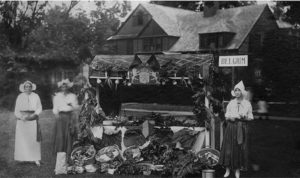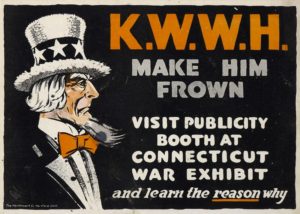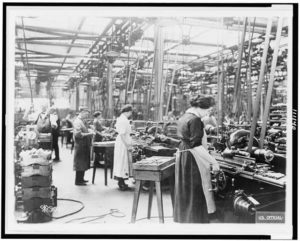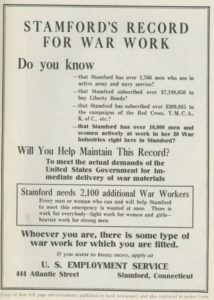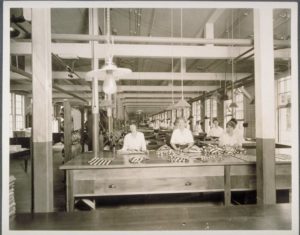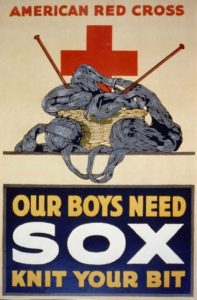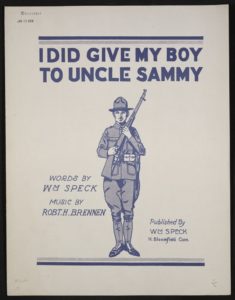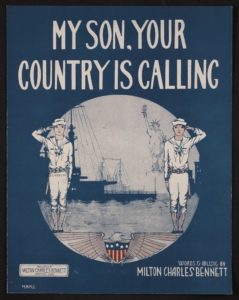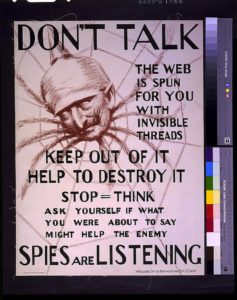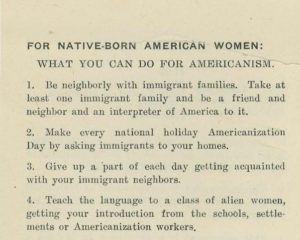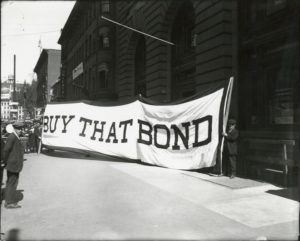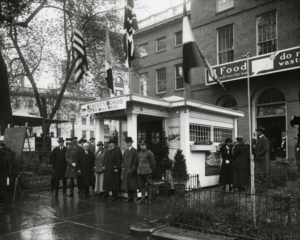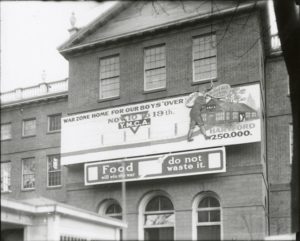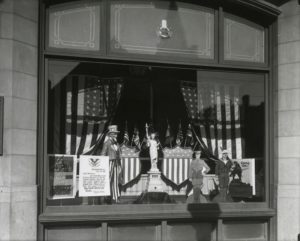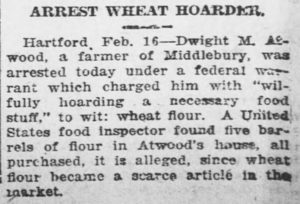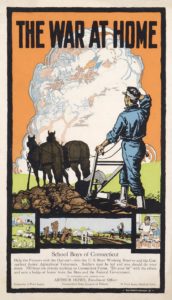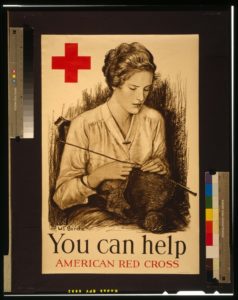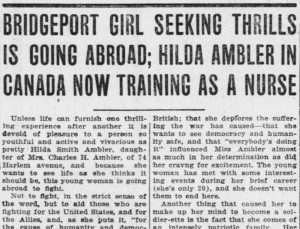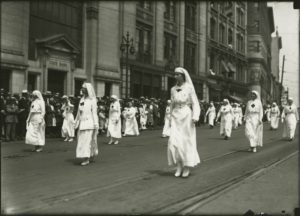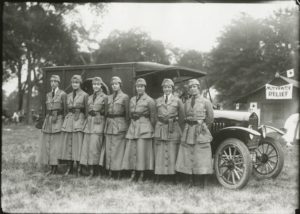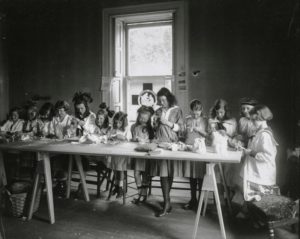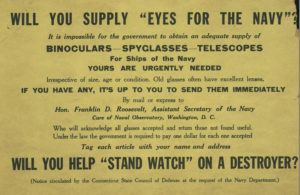World War I (1917-1918)
When the United States entered Europe’s Great War in 1917, Connecticut manufacturers provided the military with munitions, clothing, and other goods. From Manchester silk and Waterbury brass to Bridgeport’s Remington Arms, which produced 50 percent of the US Army’s small arms cartridges, the industrial ramp up—and curtailed immigration from Europe—produced labor shortages. African Americans migrating from the South sought to fill these jobs. Many found opportunity and settled, but they also encountered racial discrimination from whites and class prejudice within established black communities. In addition to the men and women who worked on the home front, roughly 63,000 state residents served in the US or Allied forces. Among those remembered today are flying ace Raoul Lufbery and Stubby, the canine mascot of the 102nd Infantry, 26th Yankee Division.
The Home Front:
- Photograph: The Belgium booth at “The Allied Market,” The Sister Susie Society’s first World War I fundraiser fair, held on the Washington Green on August 5, 1916 – Gunn Memorial Museum
- Document: World War I broadside referencing Kaiser Wilhelm’s Willing Helpers, ca. 1910-1919 from the Connecticut War Exhibit – Connecticut Historical Society
- Photograph: Women grinding barrels of automatic 45s, in Colt’s Patent Fire Arms Plant, Hartford, Connecticut, ca. 1914-1918. U.S. Army Signal Corps photo – Library of Congress, Prints and Photographs Division
- Book: Detail of page 11 from the booklet – How Stamford is meeting her war labor problems, 1918 – Click here for the entire booklet – Connecticut State Library
- Photograph: Women checking or sorting American flags on a counter at Cheney Brothers Silk Manufacturing Company, 1918 – Connecticut Historical Society
- Poster: “Our Boys Need Sox, Knit Your Bit,” published by the American Red Cross, ca. 1918 – Library of Congress, Prints and Photographs Division
- Document: Sheet music for voice and piano titled I Did Give My Boy To Uncle Sammy published by Wm. Speck, Bloomfield, Connecticut, 1917 – Library of Congress, World War I Sheet Music
- Document: Sheet music for voice and piano titled My Son, Your Country is Calling written Milton Charles Bennett, Hartford, Connecticut, 1917 – Library of Congress, World War I Sheet Music
- Poster: “Don’t talk, the web is spun for you with invisible threads, keep out of it, help to destroy it–spies are listening,” ca. 1918 – Library of Congress, Prints and Photographs Division
- Document: Detail of the pamphlet American Ideals, “For Native-born American Women: What you can do for Americanism, ” produced by the Connecticut State Council of Defense, ca 1917-18. Click here to download the entire PDF – Connecticut State Library Digital Collections
- Photograph: Men hold a “Buy That Bond” banner on Central Row next to the Hartford Trust Company, 1917-1919 – Connecticut State Library, State Archives, Dudley Photograph Collection of Hartford during World War I, 1917-1919 (PG 034)
- Photograph: Notables pose outside the newly installed Liberty Bond Booth in front of the Old State House to kick off the start of the Liberty Bond Drive, 1917. From L-R, Richard M. Bissell, Lt. L.D. Gibbs, former Senator Morgan G. Bulkeley, Mrs. Richard Bissell, Governor Marcus H. Holcomb, Acting Mayor Walter S. Schutz, Pvt. J.B. Pimlott – Connecticut State Library, Dudley Photograph Collection of Hartford During World War I
- Photograph: A billboard for the Y.M.C.A. on the Old State House tracks the donations Hartford made for the War Work Fund. Each day at noon, the soldier was moved to represent monies collected, ca. 1917-1919 – Connecticut State Library, Dudley Photograph Collection of Hartford during World War I
- Photograph: A window display for the Fourth Liberty Loan at the Hartford Electric Light Company, 1918 – Connecticut State Library, Dudley Photograph Collection of Hartford During World War I
- Poster: “Get behind the Girl he left behind him – Join the Land Army,” ca. 1918 – Library of Congress, Prints and Photographs Division
- Document: Article “Arrest Wheat Hoarder” from the Republican Farmer, Bridgeport, Connecticut, February 22, 1918 – Library of Congress, Chronicling America: Historic American Newspapers
- Poster: Asking the School Boys of Connecticut to Help the Farmer’s with the Harvest! Join the U.S. Boys’ Working Reserve and the Connecticut Junior Agricultural Volunteers. Soldiers Must be fed and you should do your share…, 1917 – Connecticut Historical Society
- Poster: “You can help–American Red Cross,” ca. 1918 – Library of Congress, Prints and Photographs Division
- Document: Detail from the article “Bridgeport Girl Seeking Thrills Is Going Abroad Hilda Ambler in Canada Now Training As A Nurse,” The Bridgeport Times and Evening Farmer, January 2, 1918 – Library of Congress, Chronicling America: Historic American Newspapers
- Photograph: American Red Cross nurses march down Main Street, Hartford, Connecticut, past the State Bank and Trust Company, 1917 – Connecticut State Library, Dudley Photograph Collection of Hartford During World War I (PG 034)
- Photograph: The Red Cross Ambulance Corps pose in front of the Red Cross Motor Division ambulance. The women of the Ambulance Corps were trained in motor mechanics by the Y.M.C.A., ca. 1917 – 1919 – Connecticut State Library, Dudley Photograph Collection of Hartford During World War I (PG 034)
- Photograph: Children from the Children’s Branch of the Hartford Chapter of the American Red Cross roll bandages at the Red Cross Annex on Farmington Avenue, ca. 1917 – 1919 – Connecticut State Library, Dudley Photograph Collection of Hartford During World War I (PG 034)
- Poster: World War I poster, “Save a loaf a week – help win the war,” 1917 – Library of Congress, Prints and Photographs Division
- Document: Broadside requesting citizens to donate binoculars, spyglasses, and telescopes to the Navy. “Will You Supply ‘Eyes for the Navy’?,” ca. 1914-1918, Connecticut State Council of Defense – Connecticut State Library
This TeachITCT.org activity is sponsored in part by the Library of Congress Teaching with Primary Sources Eastern Region Program, coordinated by Waynesburg University.

